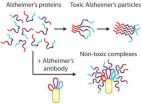(Press-News.org) Philadelphia, Pa. (December 3, 2012) – A new technology called the Pipeline embolization device (PED) shows encouraging results in patients with certain types of difficult-to-treat brain aneurysms, reports the December issue of Neurosurgery, official journal of the Congress of Neurological Surgeons. The journal is published by Lippincott Williams & Wilkins, a part of Wolters Kluwer Health.
Data collected since the PED was approved for marketing show generally good results in "real world" clinical practice. However, the report raises concerns about fatal bleeding and other serious complications, especially for aneurysms in one specific location. The lead author of the study was Dr. Peter Kan of University at Buffalo, N.Y.
Pipeline Device Shows Promising Results…
The researchers evaluated "early postmarket" results—that is, after approval by the U.S. Food and Drug Administration (FDA)—using the PED at seven surgical centers. The PED is designed for use in treating certain types of aneurysms that can't be blocked off by surgery or other treatments, such as "wide-necked" or giant aneurysms.
An aneurysm is a weakened spot in a blood vessel wall. If the aneurysm enlarges or ruptures (breaks), it can cause a stroke or life-threatening bleeding in the brain. The study reflects the increased emphasis on collecting postmarketing data on newly approved medical devices to see if the results in initial clinical experience are comparable to those in research trials. The PED received FDA approval for use in treating specific types of brain aneurysms in 2011.
The study included 62 PED procedures performed to treat aneurysms in 56 patients. The patients' average age was 59 years. More than 40 percent of the aneurysms were discovered incidentally, before they caused any symptoms or bleeding.
On average, it took two PEDs to treat each aneurysm. Some patients needed additional procedures related to problems deploying the PEDs. In one-fourth of aneurysms, additional "coil" treatments were used in addition to PEDs to help block off the aneurysm.
Three-month follow-up data were available for 19 patients. In 68 percent, the aneurysm was completely blocked off. Two patients had some narrowing within the Pipeline device—this was successfully treated with an additional angioplasty procedure.
…But Also Some Serious Complications
However, the data also showed substantial risks, including an 8.5 percent rate of major complications or death. Six patients had clots leading to strokes or transient ischemic attacks ("mini strokes") after the PED procedure. Most of these patients had vertebrobasilar aneurysms—located in an area at the base of the brain where three major arteries meet.
In addition, four patients suffered bleeding, which developed up to two months after the PED procedure. Bleeding was fatal in all four cases.
Unlike surgery or other treatments for brain aneurysms, the PED does not achieve immediate occlusion. Rather, the "Pipeline" redirects blood flow away from the aneurysm and through the parent vessel. Over time, new blood vessel tissue grows across the neck of the aneurysm, blocking it off permanently.
This initial "real world" experience with the PED shows results similar to those achieved in clinical trials leading to FDA approval. Although treatment may take months to complete, the aneurysm is eventually completely occluded in most patients. Thus the PED offers an effective new option for patients with aneurysms that would previously have been difficult or impossible to treat.
The postmarketing data also show a significant risk of serious complications, including potentially fatal bleeding. Pending further study, Dr. Kan and colleagues caution against "off-label" use of the PED to treat aneurysms in the vertebrobasilar region. They conclude, "Long-term data are needed to establish long-term efficacy and to understand the delayed complications of this new technology."
###
About Neurosurgery
Neurosurgery, the Official Journal of the Congress of Neurological Surgeons, is your most complete window to the contemporary field of neurosurgery. Members of the Congress and non-member subscribers receive 3,000 pages per year packed with the very latest science, technology, and medicine, not to mention full-text online access to the world's most complete, up-to-the-minute neurosurgery resource. For professionals aware of the rapid pace of developments in the field, Neurosurgery is nothing short of indispensable.
About Lippincott Williams & Wilkins
Lippincott Williams & Wilkins (LWW) is a leading international publisher of trusted content delivered in innovative ways to practitioners, professionals and students to learn new skills, stay current on their practice, and make important decisions to improve patient care and clinical outcomes. LWW is part of Wolters Kluwer Health, a leading global provider of information, business intelligence and point-of-care solutions for the healthcare industry. Wolters Kluwer Health is part of Wolters Kluwer, a market-leading global information services company with 2011 annual revenues of €3.4 billion ($4.7 billion).
END
Troy, N.Y. – Antibodies developed by researchers at Rensselaer Polytechnic Institute are unusually effective at preventing the formation of toxic protein particles linked to Alzheimer's disease and Parkinson's disease, as well as Type 2 diabetes, according to a new study.
The onset of these devastating diseases is associated with the inappropriate clumping of proteins into particles that are harmful to cells in the brain (Alzheimer's disease and Parkinson's disease) and pancreas (Type 2 diabetes). Antibodies, which are commonly used by the immune system to target foreign ...
ROSEMONT, Ill.—Extreme heat or cold can cause dangerous and potentially fatal side effects in athletes. A literature review appearing in the December 2012 issue of the Journal of the American Academy of Orthopaedic Surgeons (JAAOS) provides an overview of the risk factors, signs and symptoms, and management of various conditions related to excessive heat and cold exposure.
"Both extreme heat and cold can be challenging for athletes during training and competition," said lead study author Benjamin Noonan, MD, MS. "One role of the team physician is to educate coaches and ...
Using deceptive behavioral patterns of squirrels and birds, researchers at the Georgia Institute of Technology have developed robots that are able to deceive each other. The research is funded by the Office of Naval Research and is led by Professor Ronald Arkin, who suggests the applications could be implemented by the military in the future. The research is highlighted in the November/December 2012 edition of IEEE Intelligent Systems.
Arkin and his team learned by reviewing biological research results that squirrels gather acorns and store them in specific locations. ...
WINSTON-SALEM, N.C. – Dec. 3, 2012 – College football and basketball games may provide more than a way for students to show school spirit – they could help prevent the flu.
According to a new study by researchers at Wake Forest Baptist Medical Center, colleges and universities should implement new or improved influenza vaccine strategies, such as giving flu shots at sporting events or during campus-wide, day-long campaigns, to increase the number of their students who get the annual flu vaccine.
In the early online edition of the December issue of the Journal of American ...
Reston, Va. (December 3, 2012) – In the management of gliomas—or tumors that originate in the brain—precise assessment of tumor grade and the proliferative activity of cells plays a major role in determining the most appropriate treatment and predicting overall survival. Research published in the December issue of The Journal of Nuclear Medicine (JNM) highlights the potential of imaging with 3'-deoxy-3'-F-18-fluorothymidine (F-18-FLT) positron emission tomography (PET) to noninvasively and accurately provide tumor-specific details to guide management of patients with gliomas.
Gliomas ...
University of Illinois researchers have developed a model that uses neonatal piglets for studying infant brain development and its effect on learning and memory. To determine if the model is nutrient-sensitive, they have done some research on the effects of iron-deficient diets.
"Iron deficiency is a major problem worldwide," said Rodney Johnson, professor of animal sciences and director of the Division of Nutritional Sciences. "Infants who experience iron deficiency during the first 6 to 12 months of age can have irreversible developmental delays in cognition."
He ...
This press release is available in Spanish.Outfitting soldiers with clothing that effectively repels or kills insects is one of the strategies U.S. Department of Agriculture (USDA) scientists are using to help protect U.S. military personnel deployed overseas against disease-transmitting mosquitoes and sand flies.
As part of the Deployed War-Fighter Protection Research Program, scientists at the Agricultural Research Service (ARS) Center for Medical, Agricultural, and Veterinary Entomology (CMAVE) in Gainesville, Fla., and other ARS laboratories are collaborating with ...
ANN ARBOR—New research from the University of Michigan School of Public Health found BPA, or bisphenol A, in fetal liver tissue, demonstrating that there is considerable exposure to the chemical during pregnancy.
Researchers also found a proportionately higher concentration of free BPA—as opposed to the conjugated forms modified by the body for elimination—further showing that in fetuses the ability to eliminate the chemical from the body is not the same as in adults.
"The general message from our research is that people have to be cognizant of the fact that the adult ...
MANHATTAN, KAN. -- A Kansas State University research team has resolved a 40-year-old debate on the role of iron acquisition in bacterial invasion of animal tissues.
The collaborative research -- led by Phillip Klebba, professor and head of the department of biochemistry -- clarifies how microorganisms colonize animal hosts and how scientists may block them from doing so. The findings suggest new approaches against bacterial disease and new strategies for antibiotic development.
The study -- in collaboration with Tyrrell Conway, director of the Microarray and Bioinformatics ...
This press release is available in Spanish.
With their ultra short X-ray flashes, free-electron lasers offer the opportunity to film atoms in motion in complicated molecules and in the course of chemical reactions. However, for monitoring this motion, the arrival time and the temporal profile of the pulses which periodically illuminate the system, must be precisely known. An international team of scientists has now developed a measurement technique that provides complete temporal characterization of individual FEL (free-electron laser) pulses at DESY's soft-X-ray ...


